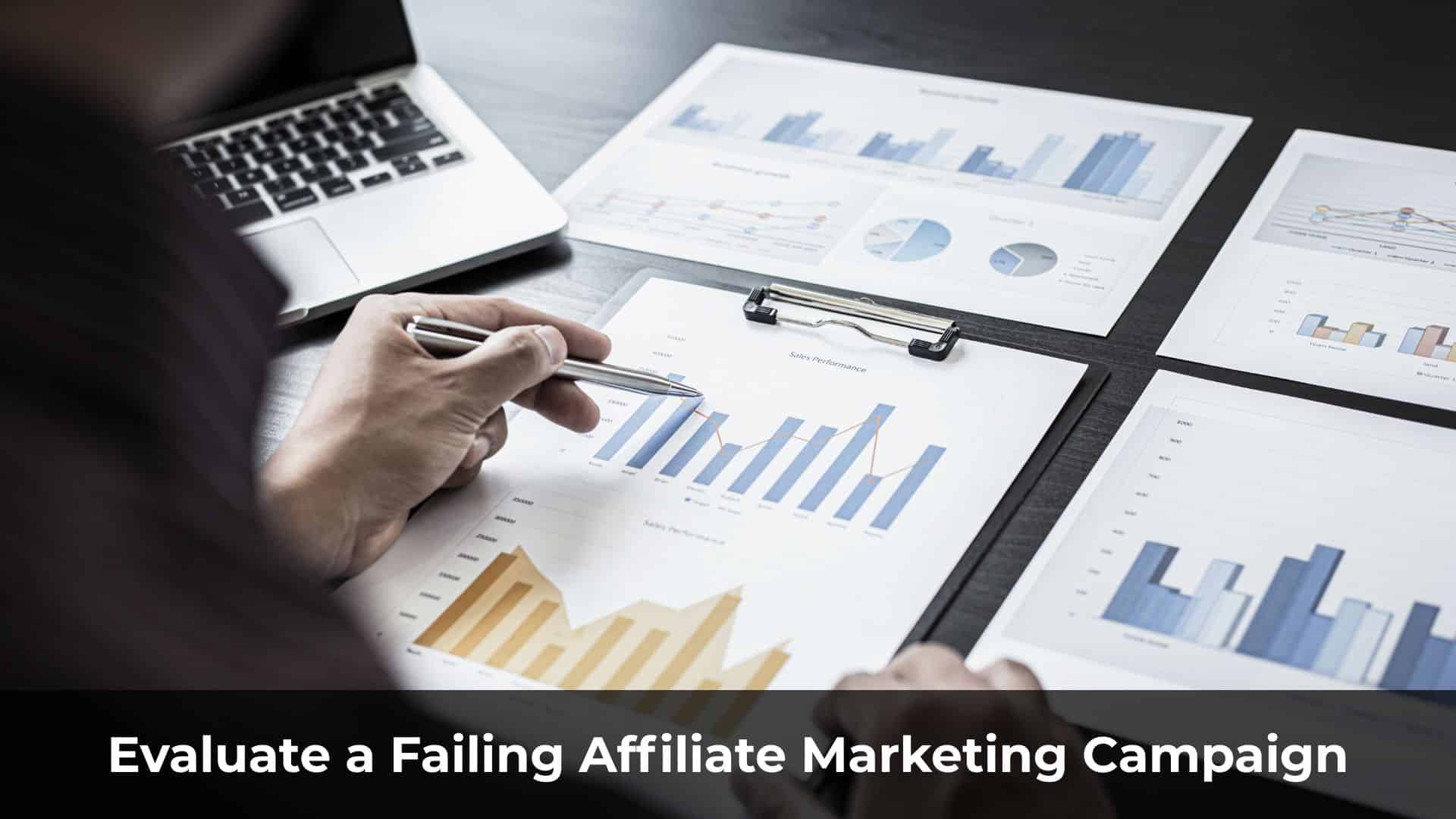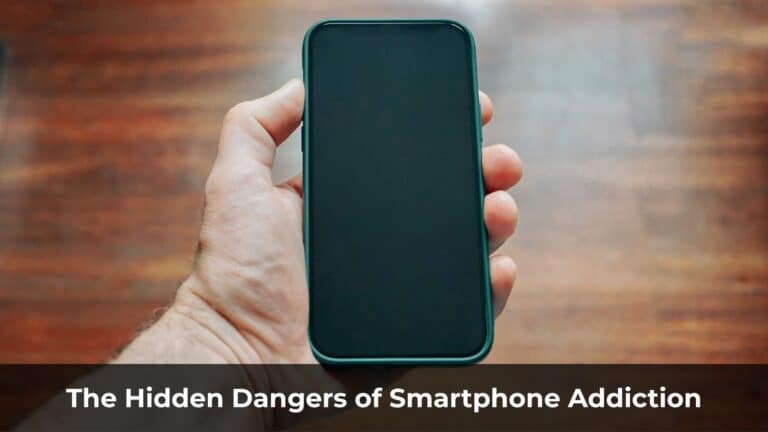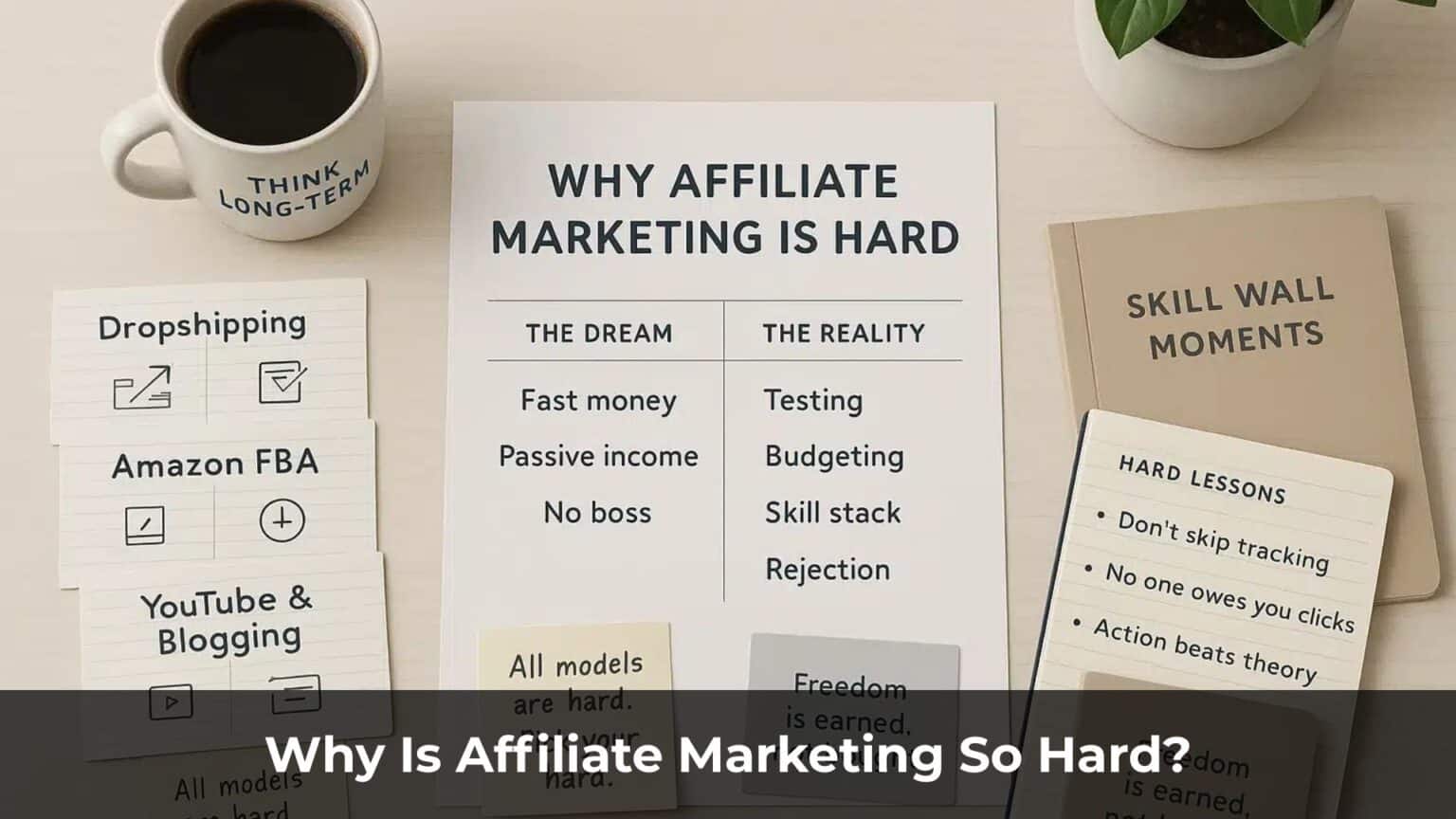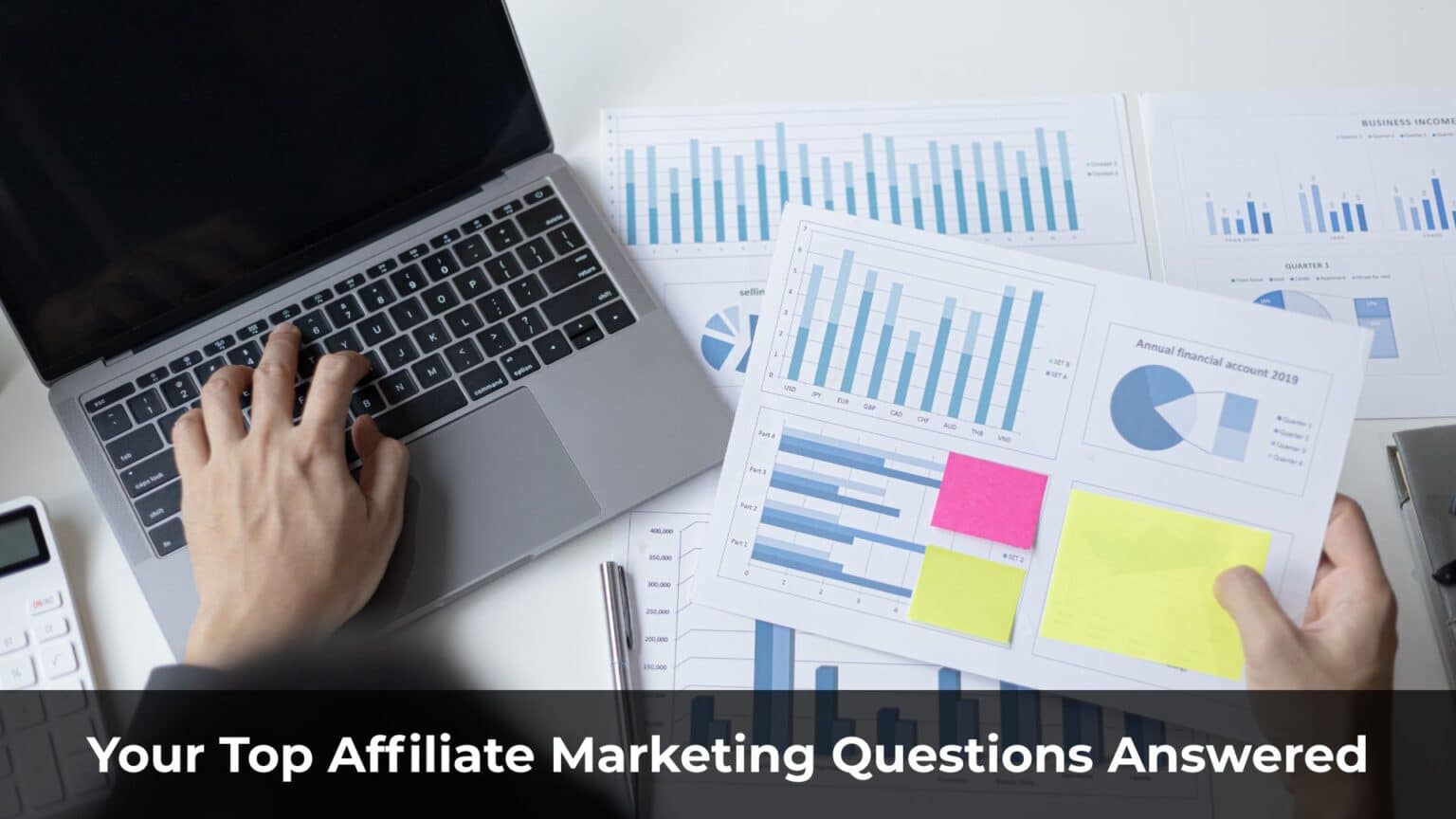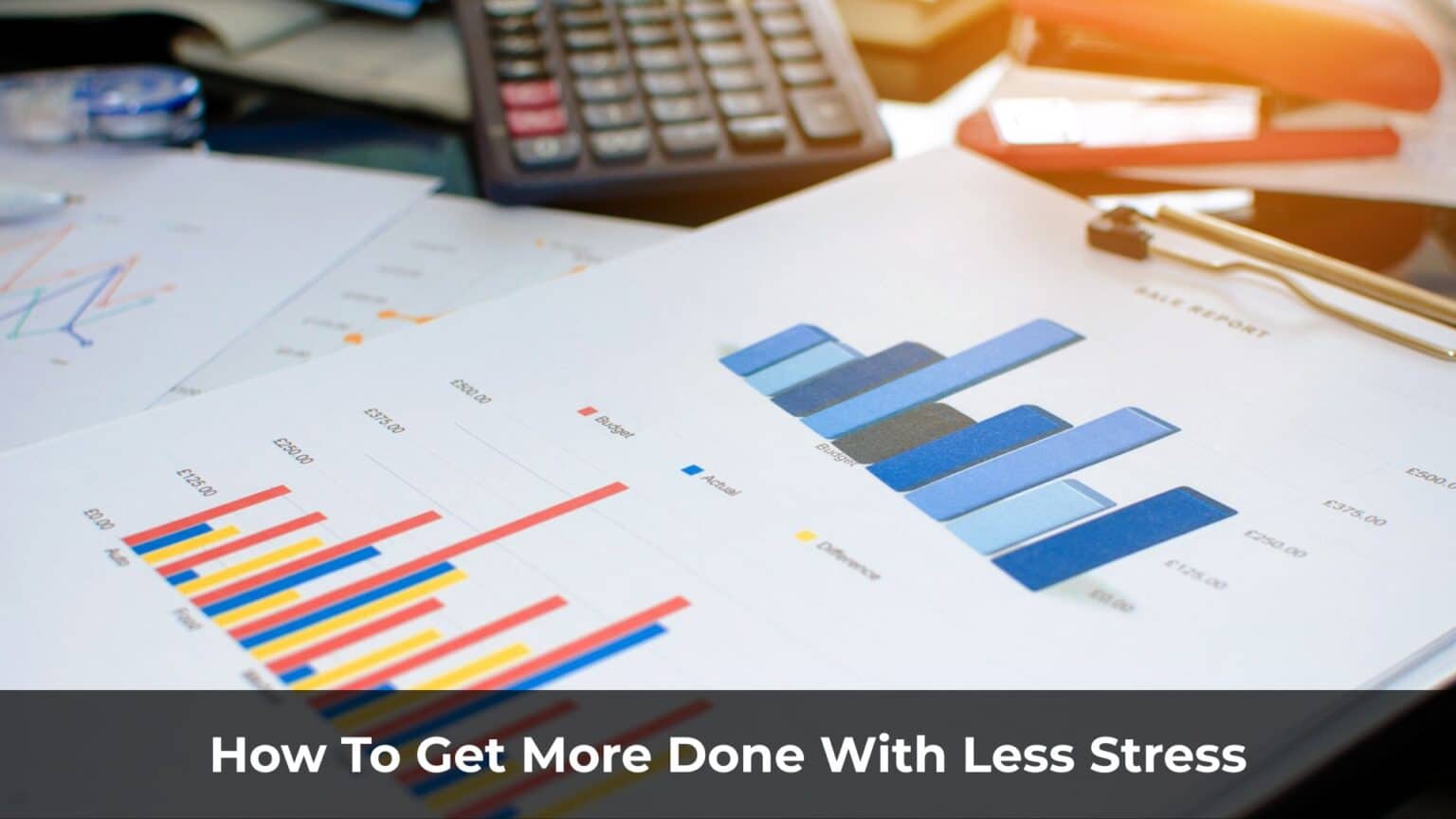You’ve just spent $300 on a Facebook ad campaign for your affiliate offer. Five days in, and still… not a single conversion.
The pixel hasn’t learned anything.
Your ad account is brand new.
Your budget is tight.
And now the doubt creeps in:
“What am I doing wrong? Is it the offer? The ad? Or… maybe I’m just not cut out for this?”
At this point, the question isn’t how to win.
It’s:
Should you keep testing and optimizing—or pause the campaign and cut your losses?
And if you stop—are you doing it because the offer genuinely lacks potential?
Or because you never gave yourself the chance to truly understand it?
This isn’t a motivational post.
It’s a tactical guide to help you understand why you’re losing money with affiliate ads—and how to make decisions based on data, not emotion.
Note: This article focuses on affiliate campaigns run with Facebook Ads. If you’re using Google, Pop, Push, or Native ads, the advice here might not apply.
Table of Contents
ToggleCommon Reasons Affiliate Campaigns Fail
Most affiliates don’t lose money because they picked a bad offer. And it’s not always because they lack ad skills either.
They lose because they set things up incorrectly from day one.
They don’t know what they’re doing. They:
- Didn’t install the pixel properly
- Had no idea how tracking works
- Couldn’t read campaign data, so optimization was impossible
- Got their ad account banned and assumed they were just “unlucky with affiliate marketing”
The result?
They’re running ads in the dark.
In paid traffic, if you don’t have campaign data—and don’t know how to analyze it—you cannot optimize.
And if you can’t optimize, you’re basically burning money.
Let’s start with one of the most common beginner mistakes: Tracking.
Mistake #1: Poor Tracking – Running Ads Without Reliable Data
You can’t optimize what you can’t measure.
But many new affiliate marketers launch campaigns without even the basics:
- No Facebook Pixel properly installed
- No Conversion API, no third-party tracking tools
- No clue where conversions are being tracked (if at all)
And then they say:
“This campaign is a failure… no sales. Must be a bad offer.”
Not true.
If you don’t set up tracking correctly, you’re not feeding Facebook the conversion signals it needs to optimize.
No tracking = no data. No data = no strategy. No strategy = bankruptcy.
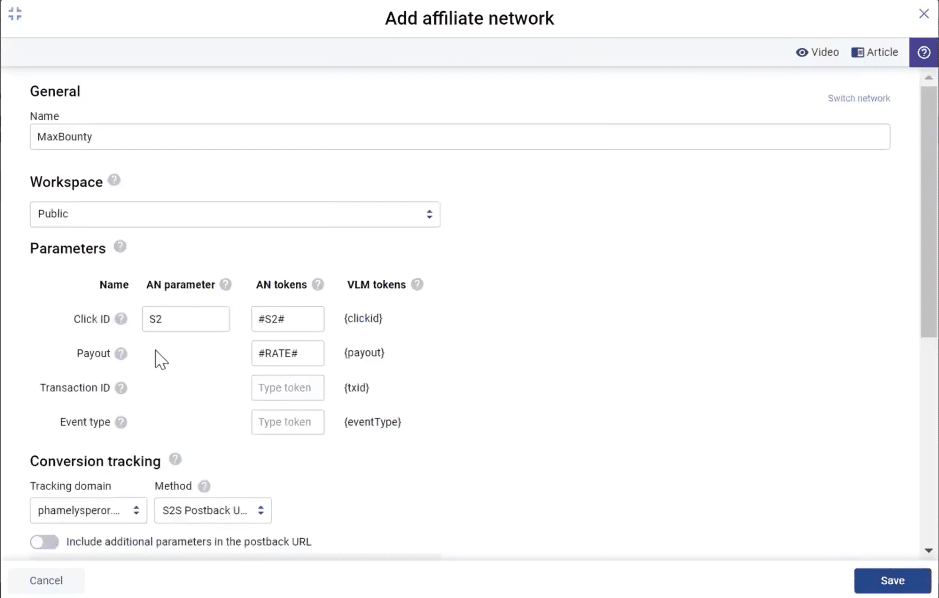
Yes—setting up tracking can be a bit technical. It can be frustrating.
But if you don’t get past this barrier, your campaigns will never perform sustainably.
Tracking is one of the least talked-about skills… but it’s one of the most important in affiliate advertising.
Why don’t people talk about it?
Because most online content focuses on “easy ways to make money.”
Tracking isn’t sexy. It’s not easy.
But it’s essential—and without it, you will fail.
Note: If you’re new to tracking, I’ve put together a free guide to walk you through setup for affiliate campaigns. You can access it here.
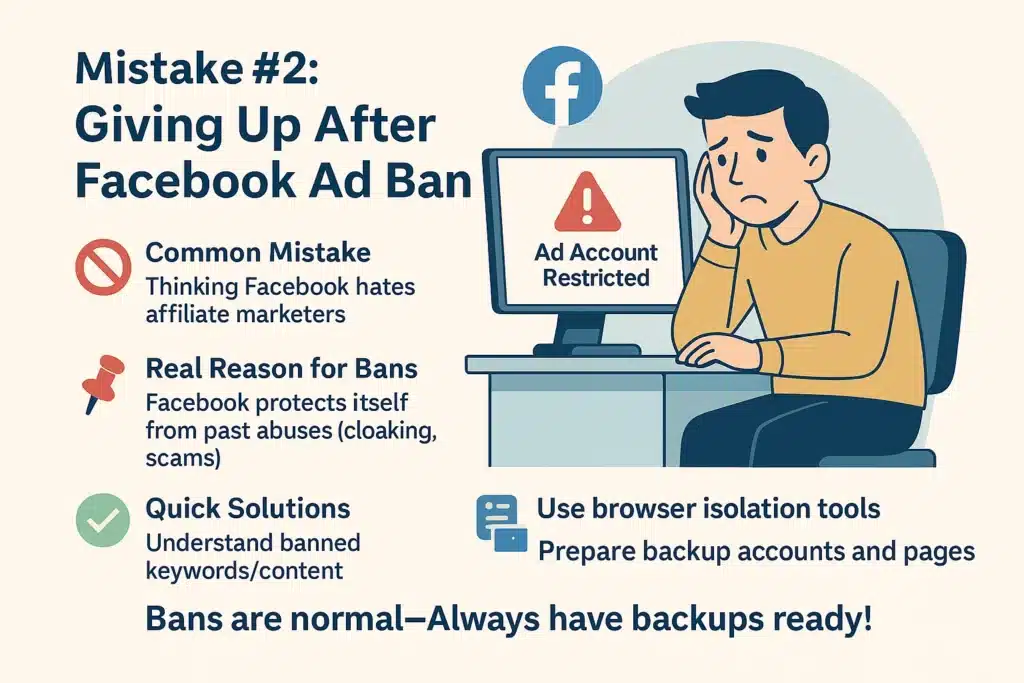
Mistake #2: Ad Account Bans – Why Many Beginners Give Up Too Soon
There’s a moment almost every beginner affiliate faces:
Your ad account gets banned.
You just launched your first campaign. You wrote your ad copy, spent $30 or $40 testing…
Then, before you even figure out what’s happening —
“Your account has been restricted.”
Frustrated, you give up and say things like:
– “Maybe I’m just not cut out for ads.”
– “Facebook is against me.”
– “Affiliate marketing is too hard. It’s not for me.”
But here’s the truth:
You didn’t fail.
You simply entered a game with stricter rules than you expected.
Facebook doesn’t love affiliate marketing.
They won’t say it out loud, but they’ve made the rules tougher for affiliate advertisers over the years.
Not because they hate you personally.
But because too many affiliates before you abused the system—using tactics like cloaking, deceptive funnels, evasion, and outright scams.
To protect their platform, Facebook enforces strict policies.
Sometimes, they’ll ban your account before you even know what rule you broke.
So if you don’t understand:
- What types of content trigger bans
- Which keywords raise red flags
- How to structure a landing page safely
…your campaign could get flagged within hours.
Here’s the mindset shift if you want to play the long game:
Getting banned is normal. Not having a backup is the real problem.
You need to be ready with new ad accounts at all times.
Learn how to “warm up” accounts properly:
- Start with low daily spend
- Avoid switching IP addresses too often
- Don’t log in from multiple devices
Use tools like MoreLogin, GoLogin, or AdsPower to simulate clean browser environments and prevent fingerprint issues when managing multiple accounts.
Always have backup Business Managers, Pages, and payment methods ready.Don’t wait for a ban to start building your next setup.
It’s not the ban you should fear — it’s having no backup when it happens.
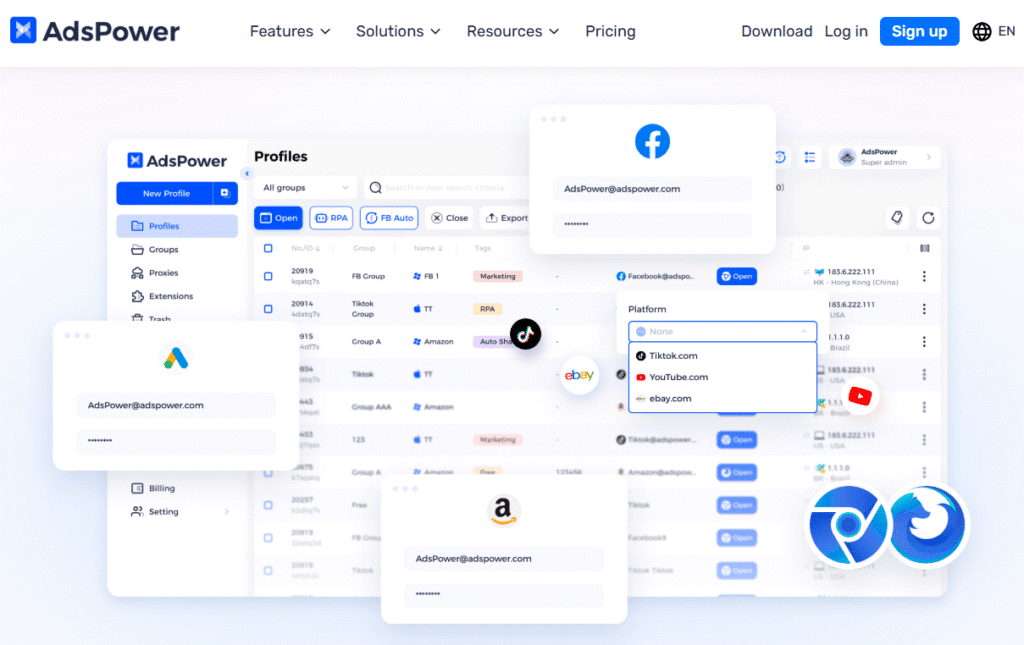
Mistake #3: Skipping Market Research – Not Using Spy Tools
One of the most common mistakes beginner affiliates make is running ads without doing any market research.
They find a product on ClickBank with a high payout and attractive commissions.
They pick it, slap together a basic landing page, toss in a few lines of copy, and hit launch.
And they hope: “Maybe I’ll get lucky.”
But affiliate marketing isn’t a game of luck.
The people making real money aren’t guessing.
They know exactly what they’re selling, who they’re selling to, and why those people buy.
That’s why serious affiliates use spy tools.
You need to see what other advertisers are doing—so you can learn, adapt, and stay competitive.
Some useful tools:
- AdSpy – Great for Facebook Ads affiliate campaigns
- BigSpy – Beginner-friendly interface, with a limited free plan
If you don’t know what angles others are using, what creatives they’re testing, or what kind of landing pages they’re sending traffic to—
It’s like going into battle blindfolded.
Spy tools are not for copying others.
They’re for understanding the landscape.
You study how other affiliates structure their ads, how they build their funnels, what kind of messaging works—and you take notes.
Not to clone them—but to learn and improve.
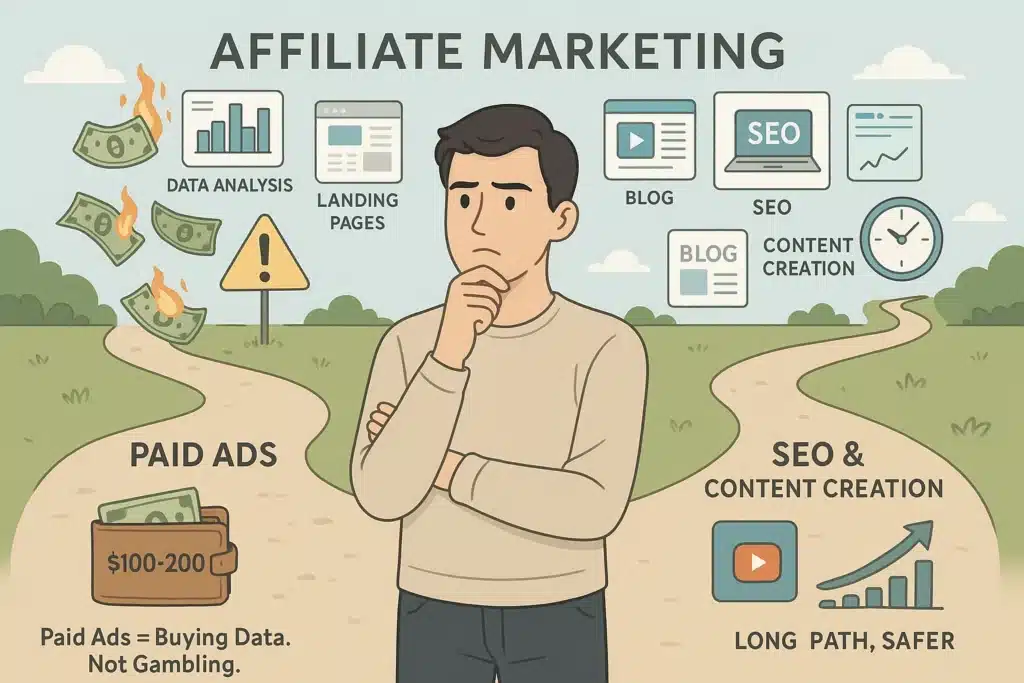
Mistake #4: Running Paid Ads Without Enough Budget
Running ads in affiliate marketing is a money-for-data game.
You don’t get sales right away.
You spend money to learn what works—what angle converts, which landing page performs, and how to optimize your campaign.
But many beginners jump in with just $100–$200 and hope they’ll “hit the jackpot.” They don’t call it gambling, but… it’s basically gambling.
They test one offer, lose $50, panic, shut it down.
Then switch to another offer—lose money again.
And instead of learning a lesson, they walk away with just one takeaway:
“Affiliate ads are dangerous. You burn money so fast.”
But paid ads aren’t the problem.
The real problem is trying to learn paid ads without having the budget to back it up.
If you’re down to your last few hundred dollars, paid traffic might not be the right starting point for you—at least not yet.
That doesn’t mean you can’t do affiliate marketing.
In fact, you absolutely can. And you can start with close to zero budget by focusing on:
- SEO
- Blogging
- Writing review articles
- Creating YouTube videos
Paid ads are the faster path—but they cost money.
Content and SEO are the slower path—but they cost time.
Both roads can lead to success.
You just have to pick the one that fits your current reality.
Whatever you do—don’t run paid ads if you can’t afford to lose the money.
When your budget is tight, every loss feels like a disaster. You’ll panic, make bad decisions, and lose even more.
I remember my early affiliate campaigns—I burned through $1,000 very quickly.
At the time, that was a huge amount for me. And I only made back $200.
But I had planned my cash flow ahead of time, so I survived.
That made all the difference.
Paid ads are for those with capital. SEO is for those with time.
Both are valid paths. What matters is choosing the one that fits you right now.
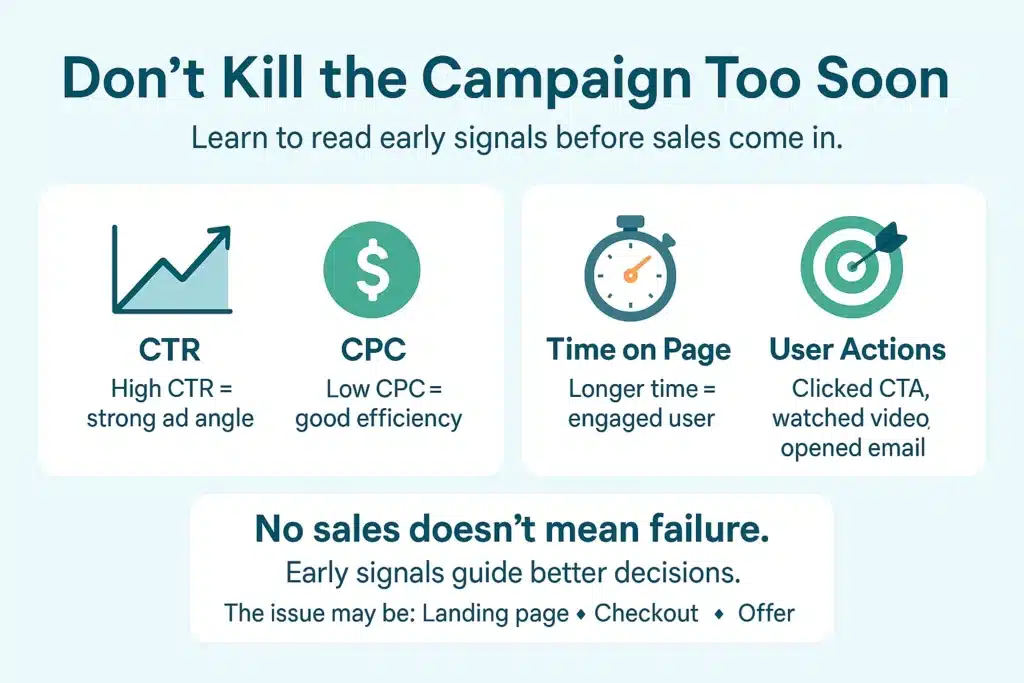
How to Evaluate a Losing Campaign (Using Data, Not Emotion)
When an affiliate campaign is losing money, the first question you should ask isn’t: “Should I turn it off?”
It’s: “Can this campaign still be optimized?”
You need to look at your data, read the signals, and assess whether there’s still room for improvement.
A campaign that starts off in the red isn’t necessarily a bad one.
It’s only bad if you don’t know why it’s underperforming.
So start by reviewing your key metrics. Ask yourself:
1. Signs Your Campaign Might Still Be Worth Saving
Before pulling the plug, take a closer look at what the data is telling you.
You might not have any sales yet—but check for early signals:
- Is your CTR high?
If people are clicking, your ad is catching attention. That’s a good sign. - Is your CPC low?
If you’re paying a low cost per click, the top of your funnel is working efficiently. - Are users staying on the landing page?
If people are spending time reading instead of bouncing, there’s potential.
You might even notice micro-engagements like:
- Clicking on your CTA buttons
- Watching your video ad all the way through
- Opening your follow-up emails (if you’re using an email funnel)
These aren’t conversions yet, but they’re signals.
And as a performance marketer, your job is to spot early signals—even before sales start coming in.
If early signs are promising, don’t hit pause too soon.
The issue might not be your ad—it could be:
- The landing page
- The checkout experience
- Or the affiliate offer itself
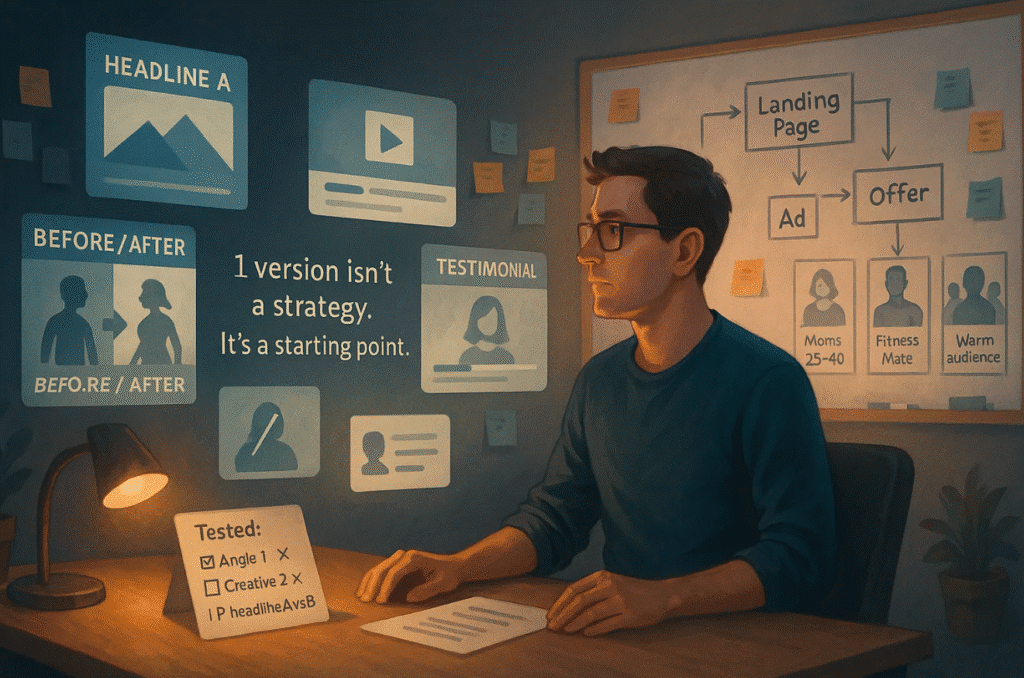
2. Have You Tested Enough Angles, Creatives, and Audiences?
One of the biggest mistakes affiliate beginners make is this:
They stop a campaign too early—believing they’ve tested everything…
When in reality, they’ve barely tested anything.
You spend $100. No sales.
You switch to a different offer.
Then you repeat the same cycle a few more times.
Eventually, you tell yourself:
“Maybe affiliate marketing just isn’t for me.”
But ask yourself honestly:
- How many different angles have you tested?
- Have you tried multiple ad formats—videos, carousels, long vs short copy?
- Have you split-tested landing pages—different headlines, layouts, CTAs?
- Have you tested different audiences—or segmented them to see which group responds best?
- If you’re running video ads, have you tried different hooks to grab attention?
If you’ve only run one ad and it didn’t work—that’s not failure.
That’s just the first data point. And you need more data before drawing any conclusions.
Professional affiliate marketers usually test at least 3–5 key variables in the early stages.
And only after a structured round of testing—with no improvements across the board—do they consider pausing the campaign.
Stopping because you’ve tested thoroughly is a strategic move.
Stopping because it “feels off” is an emotional reaction.
And when you let fear drive your decisions, you’re far more likely to make the wrong call.
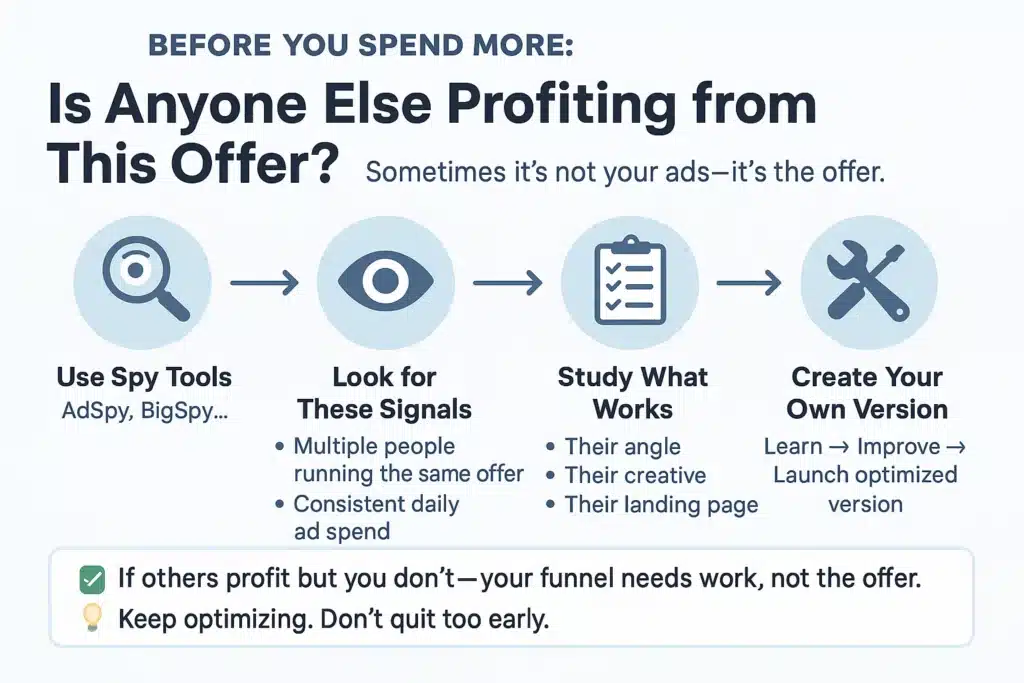
3. Are Other Affiliates Profitable with This Offer?
Before you pour more money into a losing campaign, ask yourself one crucial question: “Are other affiliates actually making money with this offer?”
Because sometimes, the problem isn’t you.
It’s not your ad creative.
It’s not your landing page.
It’s the offer itself.
As a beginner, you don’t always have the data or experience to recognize a high-converting offer. But you can observe the market.
The easiest way? Use spy tools—like AdSpy or BigSpy—to see if others are actively running ads for that offer.
Look at:
- What angles they’re using
- What creatives they’re testing
- What kind of landing pages they’re driving traffic to
If you notice:
- Multiple advertisers promoting the same offer
- Ads running consistently for several days
- Signs of retargeting or scaling up budgets
→ That’s a good signal. It means someone is making it work.
If it’s working for others, there’s a good chance you can make it work too—with the right strategy.
Study what they’re doing.
Reverse-engineer their funnels.
Look at their ad structure, their landing page layout, their call-to-actions.
Then improve upon it. Build your own version—cleaner, more persuasive, better optimized.
If other affiliates are profitable with the same offer, but you’re not—
That means your ad system isn’t fully optimized yet.
So don’t quit.
Just keep improving until it is.
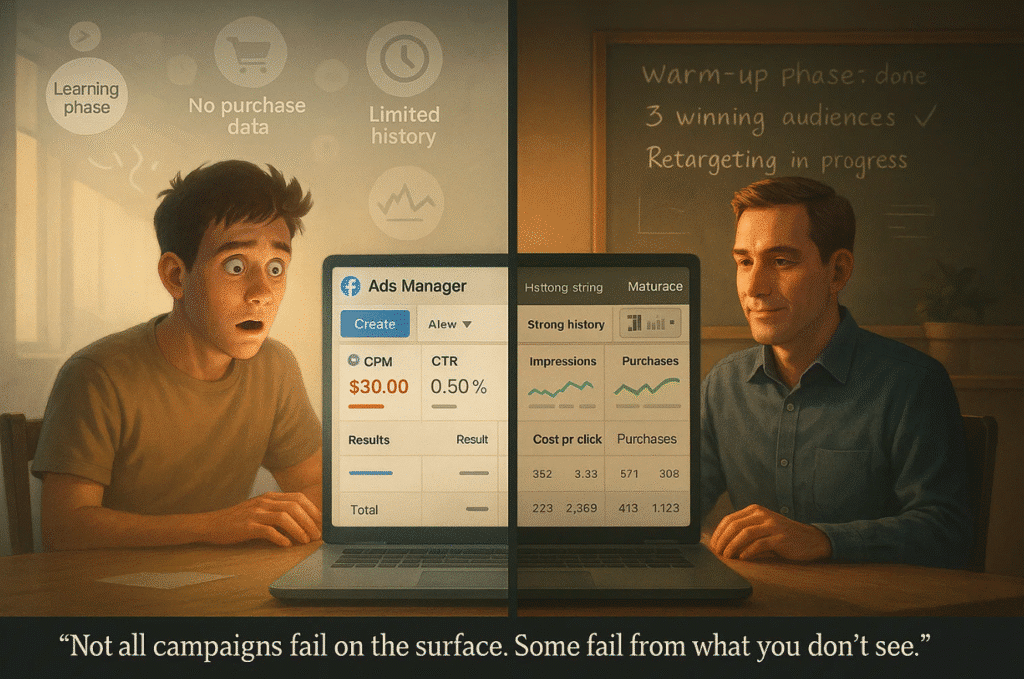
Deeper Reasons Your Affiliate Campaign Isn’t Working
Not every losing campaign fails because of a bad offer, poor setup, or incorrect targeting.
Sometimes, everything on the surface looks solid.
The funnel looks right.
Initial metrics seem decent.
But still—no conversions, or a few sales that cost too much to acquire.
In these cases, the problem often runs deeper.
It’s not what’s visible in your Ads Manager—
It’s what’s happening beneath the surface: things like account quality, learning phase dynamics, test timing, or even your own mental state as the advertiser.
Let’s start with a factor that many people overlook:
The maturity of your ad account.
1. Your Ad Account Is Too New (and Lacks Trust Signals)
You create a brand new Facebook Business account, add funds, launch your first campaign… And expect Facebook to magically help you get sales?
That’s not how this works.
A fresh ad account is like a complete beginner—it hasn’t learned anything yet.
It doesn’t know your audience.
It doesn’t understand your content.
Your Page has barely any likes.
The system has no trust in you, no history, and no machine learning signals to work with.
This leads to two common problems:
- Poor targeting distribution: Facebook doesn’t know who’s most likely to buy, so it distributes your ads randomly—wasting money on low-quality traffic.
- High CPMs and unstable CPCs: Since the platform doesn’t trust you yet, your ads don’t get priority placement—and that drives up costs.
That’s why two people can run the exact same offer with the exact same creative— But the seasoned account gets results, while the new account loses money.
Just like the pixel, your ad account needs to be “warmed up.”
If you’re constantly turning campaigns on and off, making abrupt changes, or violating policies— You’re sabotaging your account before it ever has a chance to learn.
What’s the Fix?
- Spend time warming up your account with low-pressure campaigns (e.g., traffic → video views → retargeting).
- Build trust and history early: consistent payments, no spammy activity, and no policy violations.
- Avoid jumping into conversion campaigns right away. Instead, switch to Conversion only after you’ve gathered clear engagement signals.
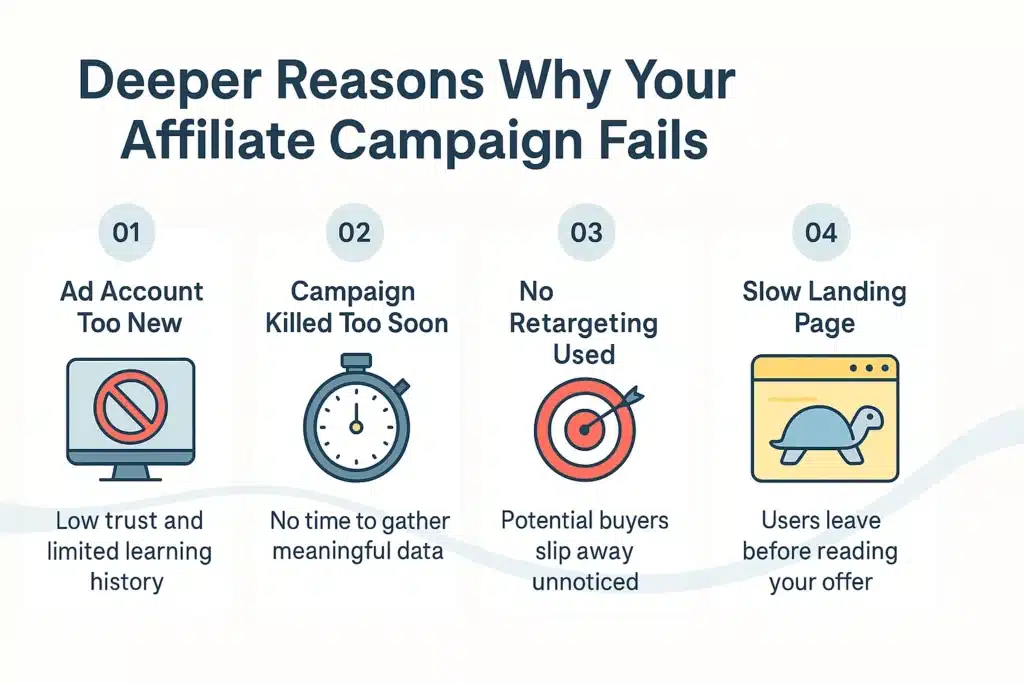
2. You’re Stopping Campaigns Too Early
One of the classic rookie mistakes in affiliate advertising is killing a campaign too early, before enough data has been collected.
You launch a campaign, let it run for a day, spend $30… no sales.
You panic.
You think: “Here we go again—another loss. Better shut it down before I waste more money.”
But here’s the problem:
That $30 isn’t enough to conclude anything.
- Your pixel hasn’t learned who your ideal customer is.
- Your ads haven’t reached enough people to identify the right audience.
- Facebook needs both time and a minimum budget to gather data and optimize properly.
If you keep switching campaigns on and off—tweaking, pausing, relaunching every day— You’re killing the system’s ability to learn.
And as a result, it will never figure out who you’re trying to reach.
With traffic sources like Mobile or Push ads, sometimes you can tell if a campaign is profitable within 15 minutes.
But Facebook and Google?
That’s a completely different game.
If you notice:
- CTR is gradually increasing
- CPC is dropping
- Your audience is responding better over time
→ Then you should let the campaign keep running.
You only pause a campaign when all metrics stagnate or get worse consistently.
And even then—don’t walk away empty-handed.
Extract insights from the data you did collect, and let that guide your next move.
3. No Retargeting – Letting Warm Leads Slip Away
In affiliate marketing, you don’t own the product.
- You can’t control the pricing.
- You can’t place a pixel on the checkout page.
- And in most cases, you don’t even get access to the customer’s email.
All you can do is drive users to a landing page you control, and from there, hope they click through to the offer page.
So if you’re not using retargeting, or you don’t have a clean front-end funnel— You’re likely losing a lot of potential customers.
People often don’t buy on the first click.
Not because they’re not interested, but because:
- They don’t trust the offer yet
- They need more time to decide
- Or simply—they got distracted
That’s why you need to implement retargeting:
- So Facebook knows who watched your video or clicked your ad
- So you can “follow up” with them in future campaigns
- And so you can convert people who were already close to buying
In paid traffic, retargeting = profit.
You don’t need to collect emails to do this.
As long as your Facebook Pixel is working correctly, you can run retargeting ads to:
- People who watched 75% or more of your video
- People who clicked your ad or engaged with it
- People who interacted with your page (if you have a Facebook Page)
This is how you build a profitable campaign—
Not from the first touch…
But from the second or third.
4. Slow Landing Pages – Users Bounce Before Seeing Anything
One of the most overlooked factors in affiliate marketing—especially when running paid ads—is landing page speed.
You could have the right angle, the right audience, and a great ad…
But if your landing page takes 5–7 seconds to load, people will bounce before they even read a word.
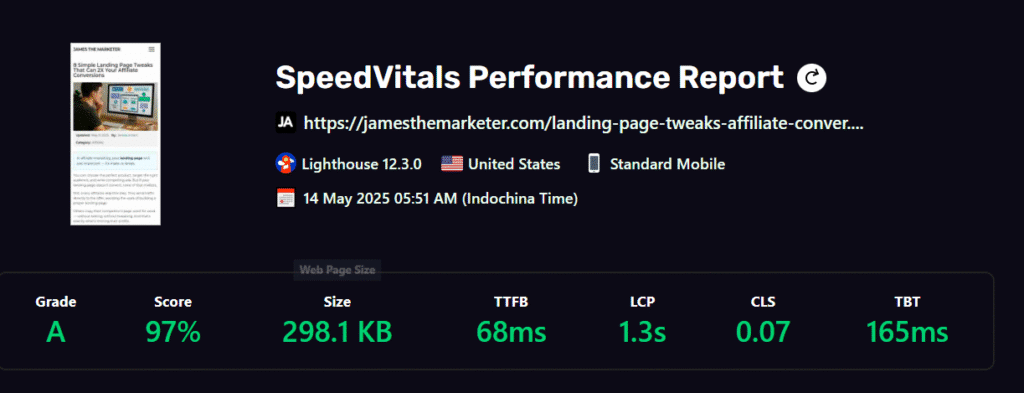
And if they don’t see your headline or engage in any way, your pixel won’t track anything. Which means you’re spending money without collecting any data.
Facebook doesn’t reward slow-loading pages.
In fact, they’ll lower your quality score or limit ad delivery if users consistently exit your site too quickly.
This becomes even more of an issue if you’re using external page builders like ClickFunnels, Kartra, or a heavy WordPress theme.
The Simple Fix:
- Use tools like PageSpeed Insights or Pingdom to measure your actual load time
- Optimize your images, remove unnecessary scripts, and use high-quality hosting
- Run A/B tests: Same ad, same offer—but with different page speeds—and you’ll clearly see the difference in CPC and CVR
So here’s the rule:
Always optimize your landing page speed.
Aim for under 3 seconds—ideally faster—before you launch your campaign.
Yes, there’s a lot to do when setting up an affiliate campaign.
But don’t worry—
The profits will be worth the effort.
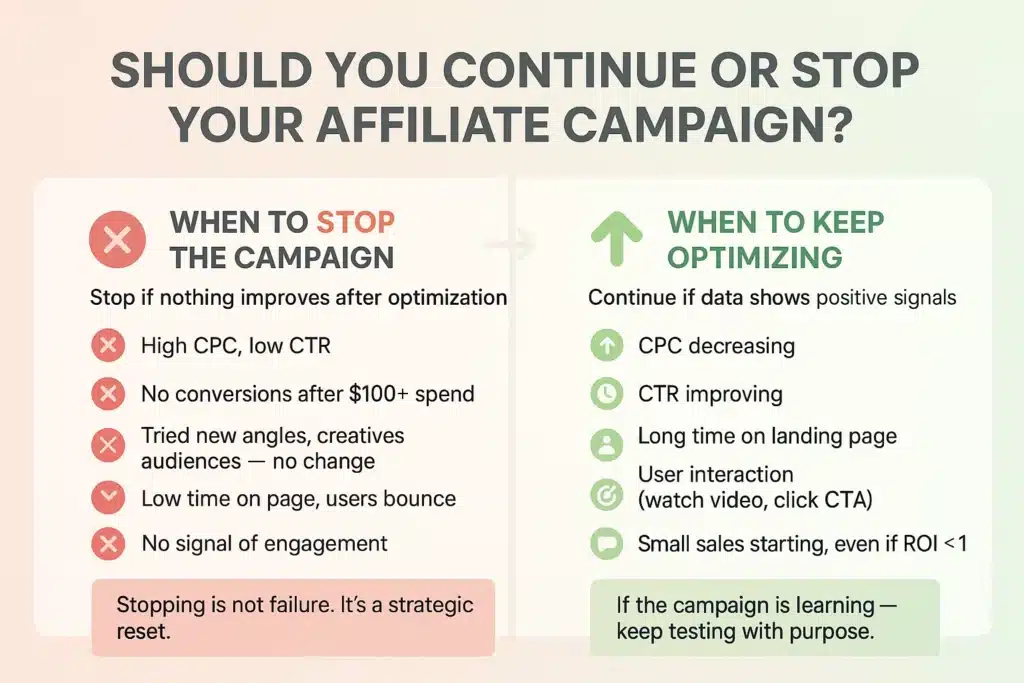
Should You Keep Running the Campaign or Shut It Down?
After you’ve run a campaign for a few days and spent a meaningful amount (usually $100 or more), the most important question becomes:
What have you learned from the data—and how will you act on it?
Here’s how I personally approach it—
Not emotionally, but based on real campaign metrics.
When It Makes Sense to Stop a Campaign
You should pause the campaign only after you’ve tested and optimized thoroughly, and still see no signs of improvement.
For example:
- You’ve tried multiple angles
- Switched out creatives
- Tested new audiences
…but your CPC is still high, CTR is still low, your landing page fails to retain users, and you’ve seen zero conversions, even after spending 10–15x the offer’s payout.
If your campaign metrics are flat across the board with no clear positive signal, then stopping the campaign isn’t failure— It’s a strategic decision.
Shutting down a campaign is how you:
- Preserve your budget
- Protect your mental clarity
- And prepare for your next test—smarter and stronger
When You Should Keep Optimizing (Because It’s Warming Up)
On the flip side, some campaigns don’t generate sales immediately, but they show signs of potential.
For example:
- CPC is gradually decreasing
- CTR is climbing slowly day by day
- Time on page is high
- Users are engaging—watching the full video, clicking CTAs
- You’re getting a few small conversions, even if ROI is still slightly negative
These are indicators that the campaign is learning, warming up, and may just need a few more days to hit its stride.
In cases like this, I usually keep the campaign running—but I continue testing strategically, not blindly burning money.
The most important principle:
Don’t make decisions based on “feelings.”
If your data suggests there’s still room for optimization—keep going.
If there’s nothing left to optimize—shut it down.
Paid ads aren’t a lottery.
Affiliate marketing doesn’t reward luck.
It rewards people who can read the battlefield—and know when to pull back, regroup, and strike again.
But at the same time, you’ll need to develop your own sense of judgment.
If you’ve optimized every angle, and the best-case scenario still only breaks even or gives you razor-thin margins— It might be time to move on.
At that point, it’s about intuition.
And no one—not even me—can make that decision for you.
Every campaign is different.
One Last Thought…
If you’ve made it to the end of this post, chances are you’ve just lost money on a campaign— Or maybe you’re stuck, staring at numbers in Ads Manager that refuse to move.
You’re not alone.
Almost everyone who starts with paid traffic feels this way at some point:
The losses, the doubt, the voice in your head that says maybe you’re just not cut out for affiliate marketing.
But here’s the truth:
Losing money isn’t failure. It’s the price of learning.
Top media buyers don’t win because they discovered a secret hack.
They win because they’ve run hundreds of campaigns.
Each one taught them something:
How users behave. How platforms really work. How to spot patterns in chaos.
If you want to take affiliate marketing seriously, don’t chase shortcuts.
Build a system instead:
- Learn how to pick the right offers
- Spy on the market before you launch
- Test methodically, not emotionally
- Track everything—accurately
- Read your data, optimize with intent
- Know when to stop a campaign if it’s going nowhere
Let your losses teach you.
If you have budget—run paid ads with intention.
If you don’t—use your time to master SEO and content.
There’s no single right path.
Just the one that fits your situation.
Whatever path you choose—I’m rooting for you.
